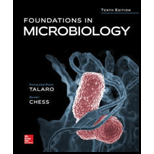
Foundations in Microbiology
10th Edition
ISBN: 9781259705212
Author: Kathleen Park Talaro, Barry Chess Instructor
Publisher: McGraw-Hill Education
expand_more
expand_more
format_list_bulleted
Concept explainers
Question
Chapter 17.6, Problem 17CYP
Summary Introduction
Introduction:
Immunoassay are techniques that have the capability to detect even minute quantities of antigen or antibody using radioisotope labels, enzyme labels, and sensitive electronic sensors. Many of them are also based on monoclonal antibodies. Immunoassay techniques involve radioimmunoassay (RIA) and enzyme-linked immunosorbent assay (ELISA).
Expert Solution & Answer
Want to see the full answer?
Check out a sample textbook solution
Students have asked these similar questions
Explain the differences between direct and indirect procedures inimmunoassay tests, giving examples.
Explain how labeled antibodies are used in direct and indirect tests.
Provide some reasons in vivo tests would not be as reliable as immunoassaytests.
Chapter 17 Solutions
Foundations in Microbiology
Ch. 17.1 - Describe what is involved in the main categories...Ch. 17.1 - Explain several techniques in specimen collection...Ch. 17.1 - Summarize the main procedures in isolation,...Ch. 17.1 - Summarize the major techniques in identifying and...Ch. 17.1 - Describe the general principles in specimen...Ch. 17.1 - Explain why it is important to prevent microbes...Ch. 17.1 - Summarize the kinds of tests that are used to...Ch. 17.2 - Describe some direct methods of testing a...Ch. 17.2 - Summarize the aims in selection of culture...Ch. 17.2 - Prob. 6ELO
Ch. 17.2 - Describe how flowcharts and comparison tables are...Ch. 17.3 - Explain the different variations on genetic...Ch. 17.3 - Describe what is involved in direct specimen...Ch. 17.3 - Prob. 6CYPCh. 17.3 - Describe the applications of PCR in identification...Ch. 17.4 - Describe the background aims of immunologic...Ch. 17.4 - Identify how antigen-antibody reactions are...Ch. 17.4 - Prob. 11ELOCh. 17.4 - Explain the basic methods behind the Western blot...Ch. 17.4 - Prob. 13ELOCh. 17.4 - What is the basis of serology and serological...Ch. 17.4 - Differentiate between specificity and sensitivity.Ch. 17.4 - Prob. 10CYPCh. 17.4 - Prob. 11CYPCh. 17.4 - Prob. 12CYPCh. 17.4 - Prob. 13CYPCh. 17.4 - Give examples of several tests that employ...Ch. 17.4 - What is meant by complement fixation? What are...Ch. 17.4 - Prob. 16CYPCh. 17.5 - Describe the concepts behind the main types of...Ch. 17.5 - Prob. 15ELOCh. 17.6 - Prob. 16ELOCh. 17.6 - Prob. 17CYPCh. 17.6 - Prob. 18CYPCh. 17.6 - Prob. 19CYPCh. 17.6 - Prob. 20CYPCh. 17.6 - Observing figure 17.17, indicate whether each...Ch. 17.L1 - Multiple Matching. Match each of the following...Ch. 17.L1 - Prob. 2MCQCh. 17.L1 - Prob. 3MCQCh. 17.L1 - Prob. 4MCQCh. 17.L1 - A patient with a _____ titer of antibodies to an...Ch. 17.L1 - Prob. 6MCQCh. 17.L1 - Prob. 7MCQCh. 17.L1 - An example of an in vivo serological test is a....Ch. 17.L1 - Which of the following specimens must be removed...Ch. 17.L1 - Prob. 1CSRCh. 17.L1 - Prob. 2CSRCh. 17.L1 - Prob. 3CSRCh. 17.L1 - Prob. 1WCCh. 17.L1 - Prob. 2WCCh. 17.L1 - Briefly describe the principles and give an...Ch. 17.L1 - Prob. 4WCCh. 17.L1 - Prob. 5WCCh. 17.L1 - Prob. 6WCCh. 17.L2 - Prob. 1CTCh. 17.L2 - Prob. 2CTCh. 17.L2 - Why do some tests for antibody in serum (such as...Ch. 17.L2 - Prob. 4CTCh. 17.L2 - Prob. 5CTCh. 17.L2 - Prob. 6CTCh. 17.L2 - From chapter 3, fig 3.17a (reproduced on the...Ch. 17.L2 - Prob. 2VC
Knowledge Booster
Learn more about
Need a deep-dive on the concept behind this application? Look no further. Learn more about this topic, biology and related others by exploring similar questions and additional content below.Similar questions
- Briefly describe the principles and give an example of the use of aspecific test using immunoelectrophoresis, Western blot, complementfixation, fluorescent testing (direct and indirect), and immunoassays(direct and indirect ELISA).arrow_forwardDescribe the term serology and explain the immunologic principle behind serological tests.arrow_forwardIdentify the advantages of alternative immunization strategies as compared to traditional immunization procedures.arrow_forward
- Differentiate process of the reaction for capture assays. Compare to other immunoassays like competitive and non-competitive.arrow_forwardBriefl y describe the principles and give an example of the use of a specifi c test using immunoelectrophoresis, Western blot, complement fi xation, fl uorescent testing (direct and indirect), and immunoassays (direct and indirect ELISA)arrow_forwardWhy monoclonal antibodies method is better than polyclonal antibodies method in detecting specific pathogen? Explain the reasons for both selection or rejection methods..arrow_forward
arrow_back_ios
arrow_forward_ios
Recommended textbooks for you
